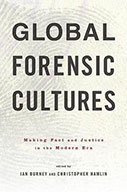Global Forensic Cultures: Making Fact And Justice In The Modern Era

Editors: Ian Burney and Christopher Hamlin
Publisher: Baltimore, MD: Johns Hopkins University Press, 2019. 357p.
Reviewer: Frank Crispino │ July 2020
Global Forensic Cultures draws up from the nineteenth century onward a more diversified alternative of its implementation and evolution from local practices decoded by historians of science and medicine, a legal scholar and a forensic pathologist. The book contains eleven interesting chapters, written by scholars in their respective fields and edited by Ian Burney and Christopher Hamlin. The book incorporates political, social and cultural factors that led to the introduction, exercise and acceptance of science-based (or so-claimed) techniques for security and justice.
The chapters which are well organized and effectively written, incorporate ideologies and methodologies of different countries of various procedural systems (Germany, British India, Spain, Palestine, Egypt, South Africa, United States of America, Thailand and France) throughout their book. This underlines the universality of the process, and supports the oxymoron hidden in the title of the book.
The contributors, who are leaders in various fields, provide essays that address the intricate and argumentative histories of forensic techniques. They further discuss and examine the co-evolution of these techniques with the professions creating and using them. For example, historian of science Christopher Hamlin’s foreword (Forensic Facts, the Guts of Rights) convincingly supports the thesis, that forensic science reaches today the status of a popular cult of scientific “constant and worldwide security of each” (P 2), conceived or narrated as a guarantee to protect our human rights.
The essays provide a global perspective and cultural history of forensic science. The chapters interface persuasively establishing how modern forensic science is inseparably associated to ethnicity, location, and nationalism. The chapters address the following which will keep the readers attention: The rise of German toxicology (chapter 1), British imperial serology (2) and early handwriting artisanal science in the Indies (3), the emergence of bloodstain pattern analysis in the USA (4), the beginning of modern medico legal investigation in the European Empires (5, 9), the building of police science in Spain relying on dactyloscopy (6), the shift of dog scent in Palestine and tracking in Punjab from police tools to justice evidence (7, 10), the cultural context-driven of DNA interpretation in Thailand (8). All of these chapters emphasize the role of national and colonial networks, as resumed in chapter 11 for the British Empire, to build tools for the targeted populations and to control the natives, adapting or taking advantage of local, cultural and social contingencies. To settle this various states of the art, accredited scientific authorities emerged to validate the current practices, mainly from the very milieus that had developed the tools to supervise, or control the populations. The contributors address systems of governance and jurisprudence in which they express socioeconomic, political, and racial ideologies.
An interesting and thought-provoking essay concludes with a final critical analysis by criminologist Simon Cole, of the current state of forensics and its questionable orientations following the NAS report (NAS, 2009). Some readers, I belong to, might consider Cole’s refocusing unfortunately too American. While acknowledging the “profound sense of history” of “many contemporary forensic thinkers” (P 327), he attributes the historical break between questions of yesteryear with those of today to the emergence of probability in forensic science. His explanation could seem too simplistic, when one integrates the disappearance of academic education integrating forensic science in criminal sciences, in the wake of WWII in Europe, and including Berkeley Criminology School under Reagan’s administration in the 80’s, with the noticeable exception of the 1909 Ecole des sciences criminelles de Lausanne. This unfortunate too American-centered conclusion leads to Cole’s claimed danger to integrate forensic assets in intelligence-led policing that would be propitious to a state police force. Notwithstanding a perceived naiveté in the American present days, he seems to deny cultural differences of perception of forensics in the various political cultures admirably covered by this book, leading to as relevant (and democratic) models as the USA for a number of non-American countries. Indeed, Cole’s relocation of forensic science in the last chapter should admit a third dimension besides the police and crime scene, the geographical one, which is at the very core of this book.
The overarch question entertained by this collected papers looks like close to Kirk’s 1963 seminal one: “Where is criminalistics, forensic science, or whatever it may be called, going?” (Kirk, 1963). For this very reason, Global Forensic Cultures is also a must-read for forensic scientists to better assess their humble contribution, but also their highly responsible duty to our societies in a historical perspective. On the formal side, besides Tardieu misspelling in the summary, only a few typo mistakes were found, unexpected for a book legitimately ambitioning an international overview : on page 30, the seminal word “Kriminalistik” (in German) has no “s” at the end, as some French titles are miswritten (P 199 and 202).
Inman, K., & Rudin, N. (2001). Principles and Practice of Criminalistics. The Profession of Forensic Science: CRC Press.
Kirk, P. (1963). “The Ontogeny of Criminalistics”. The Journal of Criminal Law, Criminology and Police Science (54), 235-238.
NAS. (2009). “Strengthening Forensic Science in the United States: A Path Forward.” Statement of the Honorable Harry T. Edwards. Retrieved from Washington DC.
Frank CRISPINO, PhD, MPhil | Professor of Forensic Science, Chemistry, Biochemistry and Physics Dept., Université du Québec à Trois-Rivières


